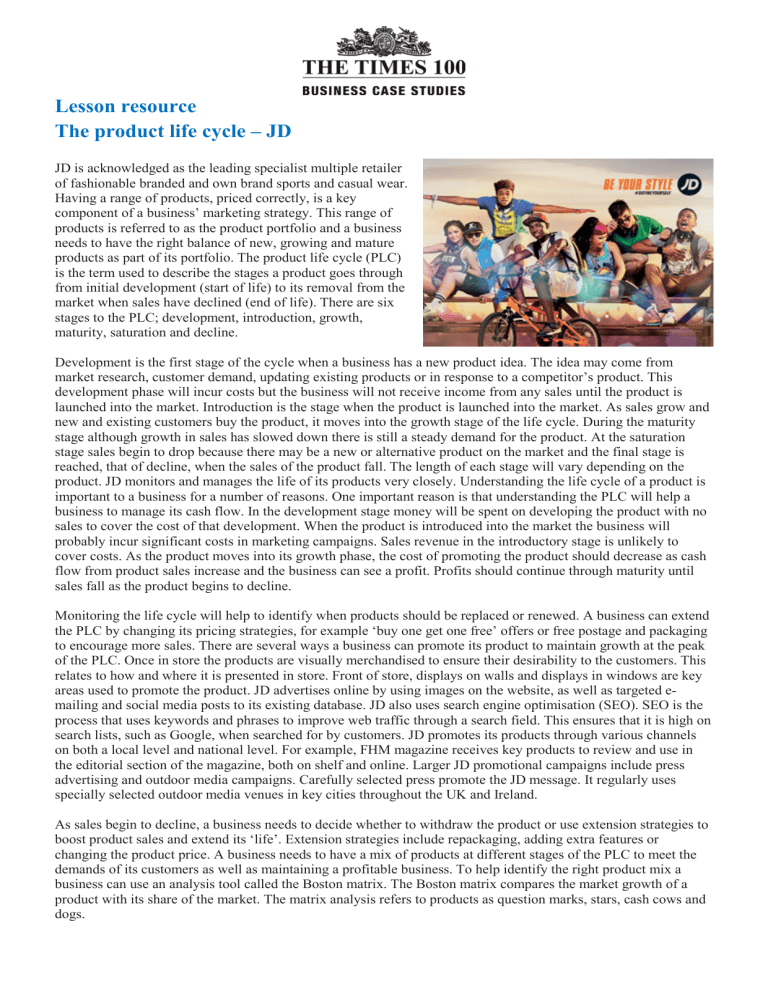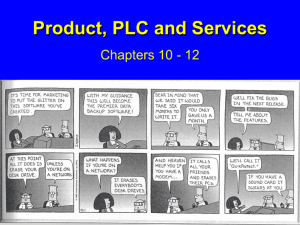jd-sports-edition-18-lesson-resource-the-product-life-cycle
advertisement

Lesson resource The product life cycle – JD JD is acknowledged as the leading specialist multiple retailer of fashionable branded and own brand sports and casual wear. Having a range of products, priced correctly, is a key component of a business’ marketing strategy. This range of products is referred to as the product portfolio and a business needs to have the right balance of new, growing and mature products as part of its portfolio. The product life cycle (PLC) is the term used to describe the stages a product goes through from initial development (start of life) to its removal from the market when sales have declined (end of life). There are six stages to the PLC; development, introduction, growth, maturity, saturation and decline. Development is the first stage of the cycle when a business has a new product idea. The idea may come from market research, customer demand, updating existing products or in response to a competitor’s product. This development phase will incur costs but the business will not receive income from any sales until the product is launched into the market. Introduction is the stage when the product is launched into the market. As sales grow and new and existing customers buy the product, it moves into the growth stage of the life cycle. During the maturity stage although growth in sales has slowed down there is still a steady demand for the product. At the saturation stage sales begin to drop because there may be a new or alternative product on the market and the final stage is reached, that of decline, when the sales of the product fall. The length of each stage will vary depending on the product. JD monitors and manages the life of its products very closely. Understanding the life cycle of a product is important to a business for a number of reasons. One important reason is that understanding the PLC will help a business to manage its cash flow. In the development stage money will be spent on developing the product with no sales to cover the cost of that development. When the product is introduced into the market the business will probably incur significant costs in marketing campaigns. Sales revenue in the introductory stage is unlikely to cover costs. As the product moves into its growth phase, the cost of promoting the product should decrease as cash flow from product sales increase and the business can see a profit. Profits should continue through maturity until sales fall as the product begins to decline. Monitoring the life cycle will help to identify when products should be replaced or renewed. A business can extend the PLC by changing its pricing strategies, for example ‘buy one get one free’ offers or free postage and packaging to encourage more sales. There are several ways a business can promote its product to maintain growth at the peak of the PLC. Once in store the products are visually merchandised to ensure their desirability to the customers. This relates to how and where it is presented in store. Front of store, displays on walls and displays in windows are key areas used to promote the product. JD advertises online by using images on the website, as well as targeted emailing and social media posts to its existing database. JD also uses search engine optimisation (SEO). SEO is the process that uses keywords and phrases to improve web traffic through a search field. This ensures that it is high on search lists, such as Google, when searched for by customers. JD promotes its products through various channels on both a local level and national level. For example, FHM magazine receives key products to review and use in the editorial section of the magazine, both on shelf and online. Larger JD promotional campaigns include press advertising and outdoor media campaigns. Carefully selected press promote the JD message. It regularly uses specially selected outdoor media venues in key cities throughout the UK and Ireland. As sales begin to decline, a business needs to decide whether to withdraw the product or use extension strategies to boost product sales and extend its ‘life’. Extension strategies include repackaging, adding extra features or changing the product price. A business needs to have a mix of products at different stages of the PLC to meet the demands of its customers as well as maintaining a profitable business. To help identify the right product mix a business can use an analysis tool called the Boston matrix. The Boston matrix compares the market growth of a product with its share of the market. The matrix analysis refers to products as question marks, stars, cash cows and dogs. Questions 1. Describe the stages of the product life cycle? 2. Explain the relationship between sales and profits during each stage of the product life-cycle. 3. Evaluate the possible actions a business might take if sales of the product start decline. 4. Analyse the importance of monitoring the product life cycle to organisations like JD. Task Investigation – select a consumer product and carry out an investigation in to its life cycle. Include when it was first launched, and identify which stage of the life cycle the product is currently at, as well as any extension strategies that have been used. The information found should be illustrated in the form of a product life cycle diagram timeline. What have you learned? Working in pairs list 10 products that you are both familiar with. Individually, decide which stage of the life cycle you think each product is currently at. Compare and justify your decisions. What does this tell you about product life cycles?

